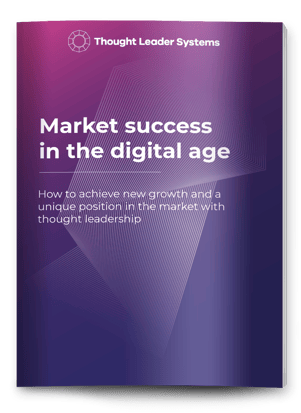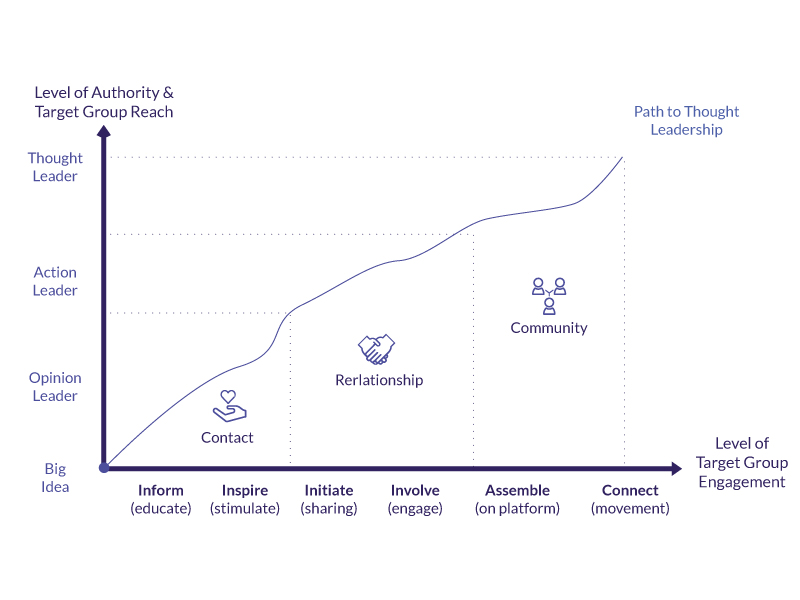Step 1: Establish contact and resonance
To inspire people for a great idea for the benefit and well-being of all. Inspire with resonant content and make
the idea come alive.
Thought leadership is not (only) about being the market leader, but about defining a market alone - in people's minds. Not being the first, but the only one.
The way there leads through the hearts of the people, because customers do not want products or services, but the fulfillment of their personal wishes and dreams. This applies not only to the marketing of smartphones or motorcycles. But also for B2B marketing, high-tech marketing, pharmaceutical marketing, financial services marketing, and last but not least for marketing and sales of management consultancies.
To inspire people for a great idea for the benefit and well-being of all. Inspire with resonant content and make
the idea come alive.
A dedicated brand community for customers
with interactive platforms and create fans. With them the mission of the brand.

Would you like to increase your sales sustainably and strengthen your brand?
Thought Leadership Marketing starts with the vision and idea of the business model. Design your business model in such a way that you inspire, involve, and even actively involve people. Create contact and resonance with people through information and inspiration with valuable content and credible brand faces.
Actively involve people in your brand world - with influencer marketing, customer engagement, and customer experience management. Use inbound marketing to create outstanding content that customers search the web for and build customer relationships with. Your customers become more involved and actively recommend you as a "brand evangelist"
(Word of Mouth).
Create your own brand community, i.e. a platform on which customers and interested parties can continue the dialogue of your brand independently. Encourage dialogue and viral effects among your customers and prospects in your own customer community. The result is your integrated thought leader system with the business model, brand, range of services, and marketing or sales.

Classic advertising achieves excellent results when it comes to reaching large crowds with uniform messages. Above-the-line campaigns in TV, radio, print, and on posters can quickly create a high level of awareness and recall. But only comparatively rarely can advertising stimulate and inspire people to engage more intensively with an idea or a brand. In addition, without the real will of the viewer, these advertising messages penetrate them as interruption marketing and are therefore literally faded out.
Modern content marketing goes a decisive step further here. It focuses on reaching people with suitable messages and inspiring formats exactly where and when they are already interested in a certain topic.
As a result, the number and reach of blogs, video blogs (vlogs), viral campaigns, whitepapers, and eBooks are exploding. In consumer goods marketing as well as in B2B marketing and service marketing.
This "brand-generated content" is not only read but often also has an initiating or activating effect. This means that interested customers and users distribute the content because they consider it to be remarkable and useful.
They distribute content via social networks and via email to potentially interested people (sharing).

Even the producer of the world's most famous soft drink, Coca Cola, was surprised by a huge Facebook fan group that had formed without his help or knowledge.
Thought leaders plan these communities strategically from the beginning. They actively promote the emergence of user-generated content and strong bonds among users and fans of the brand. They provide their own brand platforms to help fans organize, meet, and excite each other. This is how thought leader marketing works.
Campaign management is the burning glass for the effectiveness of your marketing. You can only be truly successful here if you closely coordinate your marketing, sales, and communication activities with joint, time-limited, and measurable campaigns.
Inbound marketing is the art of being found by the customer instead of constantly bombarding him with advertising. The success of inbound marketing cannot be overlooked. If you do inbound marketing, you should master four areas:
In general, the term online marketing covers all measures that are intended to generate customer contact via an online channel.
From classic advertising and Google AdWords to content management and social media, everything belongs to this great discipline.
Buyer Personas are images of customer profiles. They contain not only socio-demographic data (etc.) of the customer types but also statements about the media usage behavior, the expected purchase decision process, i.e. the customer journey and the use of the different channels of the provider at the customer touchpoints. The management of buyer personas creates tangible
target group marketing.
Once you have created your buyer persona and have a face for each of your ideal customers, the first step in the right direction is already mastered. Now you want to understand how a customer contacts you and where they need your support most. With Customer Journey Mapping, the customer's path is mapped from the first contact to the conclusion of the purchase and enables you to specifically analyze and optimize contact points (touchpoints). This brings you ever closer to the goal of uniformly good customer experience.
The more you learn about your existing and ideal customers, the higher your company's customer intelligence will be. Products and services can be adapted to these insights, marketing measures individualized and sales pitches prepared differently. On the whole, this means for you that your company works customer-centered and thus not only increases in relevance and awareness but also more successfully.
The digital age redefines public relations, messaging, and storytelling. In addition to classic tools such as background talks, press releases, and interviews, a new phalanx of measures that make a difference has long since emerged.
Are you active exactly where your buyer persona is? In the age of social platforms like Facebook, Instagram, Twitter, and Co. there is hardly a marketing strategy that avoids social media. No matter whether you want to create awareness for your brand or answer questions from customers shortly before the purchase decision - contact via social media is more important than ever.
Present the concerns of your company and your brand in such a way that you not only inform people, but inspire and even involve them.
Brand ambassadors are not only well-known celebrity advertising faces. Also important for the development of thought leadership are credible personalities and key personnel from the company itself (so-called brand faces). These include the Chief Customer Officer and the CEO as well as the Corporate Blogger. They all shape the image of the brand in the target group and set the messages there. This "messaging" should be coordinated and planned. With thought leadership marketing, for example.
When making purchasing decisions, people today trust their circle of friends, colleagues, and renowned experts more than the providers of products and services themselves. Influencers are those people whom your target group trusts more than you. Today there are specialized bloggers, vloggers (video bloggers), forum operators and professional speakers, and authors in almost all areas of B2C and B2B marketing.
Of course, it is important and effective to enter into lasting relationships with influencers in order to gain their trust and willingness to recommend professional Word of Mouth marketing. This requires professional relationship management. It is also crucial to identify the right and important influencers for your own marketing. Social media tools can provide clues about the networking and reach of potential influencers in social media.
At the moment almost everything is offered under Customer Engagement: Referral Programs, Word of Mouth Marketing, Customer Loyalty Programs, Customer Clubs, etc. Genuine customer engagement management means conducting the dialogue with EVERY customer individually so that their emotional involvement (Involvement) and brand loyalty grows.
And it means promoting the dialogue BETWEEN the customer - the supplier simply goes out of the way and promotes the community of his customers among themselves. This requires courage, experience, and good technical infrastructure in marketing, social media, and communication.
CRM is a good old acquaintance in many companies. It is very exciting how different Customer Relationship Management is understood and lived in companies. You can clearly see the customer orientation and customer view of your company from the type of relationship management you use.
Advanced CRM is linked to the company's marketing automation systems and the service area. It records and controls interactions with customers in social media, service complaints, and also activities in the brand community. Companies that clearly communicate the added value of this CRM to their customers also get its "opt-in" for much more.
Each brand can generally build a fan community. However, it should be noted that there are different categories of communities. Not every community is suitable for every brand. Active community building requires that different roles (e.g. administrator, greeter, mentor) are managed centrally. It is also important that the community not only receives an online platform but also targeted customer events and membership programs in real life.
About TLS
Contact
Newsletter